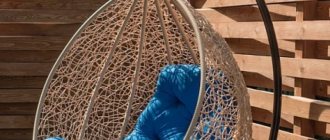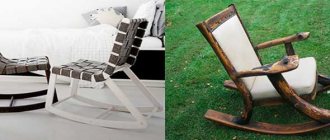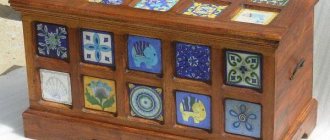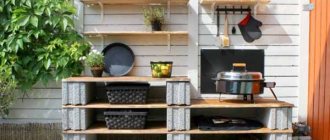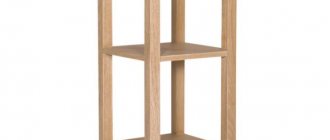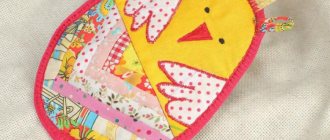Recently, original products for relaxation - hanging chairs - have begun to appear in the interiors of country houses and spacious modern apartments. They continue to rapidly gain popularity due to their unique elegant design and the feeling of extraordinary lightness and comfort. A light openwork cocoon hovering above the ground will help you relax and feel peace and tranquility.
It won’t be difficult to purchase the model you like - many large furniture and interior accessories stores offer a wide selection of products for every taste, with an amazing variety of shapes, shades and materials.
The cost of hanging furnishings is quite high; budget options for such products are simply not provided. But what to do if it is not possible to purchase an expensive copy, but you really want to decorate your home with an exclusive item? The answer is simple: you can make a hanging chair yourself. And it will be a truly unique thing.
Types of hanging chairs
The first hanging furnishings appeared in Denmark in the mid-twentieth century. At first they were used as garden hammocks, but then they gradually began to move under the roof and first took up places on terraces and balconies, then finally settled in rooms, becoming part of the home furnishings.
A floating place to relax can be made of natural materials (rattan, willow, solid wood) or artificial (plastic, metal). The structure is securely attached to the ceiling using a powerful hook, chain or cable. In addition, there are also floor products installed on a special bracket. Both seat options can rock and spin.
Amazing design, unusual shapes and different materials make it possible to adapt the product to any room. A properly made chair can withstand a weight of up to two hundred kilograms. Thanks to this, it can accommodate either two adults or an adult and a child.
All hanging models are divided into several types:
- braided type;
- textile;
- hard;
- soft.
All of them can swing or rotate, giving their owners unforgettable moments of relaxation.
During its existence, the hanging accessory has changed many times, and today there are a sufficient number of its varieties:
- rigid frame made from wicker, rattan, acrylic or plastic;
- a soft hammock chair that has compact dimensions and takes the shape of the body of the person sitting;
- the cocoon is remarkable in that its inner part is more than half hidden from those around it by openwork walls;
- The drop, which looks like a fairy-tale house, has taken root well in children's rooms.
Swing chairs are also divided according to the features of fastening (axle or rod), material and possible load. Before you make a chair with your own hands, you should decide where and how it will be used, and what load is planned on it.
How to make knots for a wicker hammock - detailed instructions and drawing
Today we talked a lot about weaving a hammock. It’s worth finding out which knots allow the hammock to hold tightly and not slip or fall! A well-stretched hammock will allow you to fully relax, and not “lie” in a position where your legs meet your head.
I’ll show you clearly how to attach a hammock, with what knots:
- Bed. If we attach the hammock to the ring.
- Bleached. If the support is thin.
- Retractable bayonet. With a thick support, this type of knot is the most reliable.
And it’s better to show here. I understand this, so I selected a video on the topic:
Advantages and disadvantages of hanging models
A hanging chair, like any piece of furniture, has its pros and cons. The undoubted advantages of a product made independently include originality and uniqueness. This copy is absolutely exclusive, as there are no others like it. Its second advantage can be called comfort. A comfortable soft seat that sways steadily in space promotes relaxation and tranquility.
The downside of the design is the difficulty of carrying it. Dismantling takes a lot of time, and after a massive hook the ceiling will be damaged. The chair on the stand is also too massive and heavy to be constantly moved.
Fabric hammock: master class with photos
relaxing in such a hammock is a pleasure
DIY tools and materials
To make a fabric hammock you will need:
- two pieces of dense fabric (2 × 0.9 and 2.12 x 0.9 m);
- two narrow fabric strips (0.9 × 0.13 m);
- 20 fabric rectangles (0.18 × 0.11 m);
- linen cord (40 m);
- two wooden slats (0.90 m each);
- scissors;
- sewing machine;
- threads;
- needle;
- iron;
- pencil;
- drill.
All materials for creating a hanging bed can be found in any hardware store, their price is low
How to make: step by step instructions
- Make the first mark with a pencil at a distance of 2.5 cm from the edge. Place the next marks in increments of 8.5 cm. There should be 10 of them in total. Check the accuracy of the markings: the latter, like the first, should deviate 2.5 cm from the edge. Make the holes so that the cord folded in half can pass through them freely.
- Drill the holes.
- Make loops from the prepared fabric rectangles: bend the edges by 0.5 cm so that the fabric does not fray, and sew.
- Take a fabric measuring 2.12 x 0.9 m.
- Fold the narrow edge on each side first by 1 cm, and then by another 5. Sew along the bottom edge of the fold.
- Place the previously made loops on both sides according to the markings on the rail: the middle of each loop should coincide with the hole. Sew the loops, stitching them crosswise for strength.
- Place both pieces of fabric right sides together and stitch both long edges, leaving about 1 cm. Turn them inside out. It is advisable to iron the resulting fabric to smooth out the seams.
- Fold each narrow strip of fabric in half with the wrong side out, iron and stitch on three sides, stepping back from the edge 0.5 cm, leaving one edge unstitched. Turn out the resulting ribbons and iron. Fold the unstitched edges inward and stitch.
- Sew the finished ribbons along the edges of the fabric near the loops - this will give additional strength to the product. It is necessary to stitch the tapes along the entire perimeter.
- Connect the canvas and slats with a linen cord.
- Make sure that the cord is tensioned evenly, converging at the suspension point at a distance of 80–90 cm from the rail.
- Thread the cord into the resulting loops and braid it, including the place where the rope loops adjoin the cord.
- Hang a hammock and enjoy your holiday!
Preparation and process of making a dream chair
You don’t need to be a special specialist to assemble a suspended structure yourself. It is enough to prepare the essentials and then diligently follow all the recommendations. To build the frame you need to prepare:
- work suit and gloves;
- measuring and cutting tools;
- thick fabric;
- blanks for rigid structures - rods or hoops made of metal, wood, PVC or acrylic;
- rigid cushioning material, grosgrain ribbons;
- nylon threads;
- filler (sintepon, foam rubber, balls);
- chain, cable, rope or sling.
These materials are available in a sufficient assortment in hardware or construction stores.
Fastening with hints of Empire style
When the mesh is ready, you can start creating fasteners.
Take a strong, rigid 50-centimeter cord (cross-section - 1 cm). Measure 5 cm on one side and 10 cm on the other, dividing the length in half. This mark is wrapped with tape, cut off and burned, removing the film. The rope is connected into a ring, tightly wrapping the joint with threads. Then the remaining section is wound to the joint. The threads are wound in 3-4 layers, while the edges are made thicker. After this, super glue is poured into the middle and also soaked on all sides.
In the store you need to buy a fastener called a thimble - a steel eyelet. It is placed on the opposite side of the winding, fixing it all with thread and filling it with glue. Then they make an openwork fastening. The principle is very simple:
- prepare 10 pieces of 2 m each in advance;
- they are thrown onto the formed shaft;
- then the upper threads are crossed with the lower ones, while the outer ones are passed between them, throwing them to the sides and carefully tightening.
After this macrame master class you will get a nice triangle. At the end of the work, there should be two cords left, which should be tied using a straight knot. Next, each axis is conscientiously tightened. This fastening is necessary in duplicate.
Spacers are made from ordinary shovel handles or plastic pipes. Holes are drilled on them at intervals of 5 cm.
Making a hanging hammock chair
For summer cottages, terraces, loggias, attics and summer rooms, a design similar to an elegant wicker macrame on a rigid frame is ideal. To assemble a hanging hammock chair with your own hands, you need to prepare either sports hoops or plastic pipes. If you don’t have the skills to weave macrame, you can use thick fabric to form the seat. But this option will be much more modest and massive.
The advantage of weaving macrame is that you will not need to connect sewing equipment and do cutting and sewing. The hanging hammock chair model is considered the simplest in design. It consists of a simple base and canvas.
To build the frame you will need two round elements of different sizes. One hoop should be a little less than a meter, the other a little more. The smaller one will be the base of the seat, the larger one will become the backrest. To weave the main part of the product you need to prepare:
- large coil of heavy-duty cord;
- 12 meter sling;
- cord for securing hoops;
- wooden supports;
- measuring and cutting tools.
The most popular are rings made from plastic pipe. They are durable, flexible and lightweight. Acrylic cord is more suitable for weaving fabric. It is soft, easy to weave, and the knots do not unravel or move.
Procedure:
- You should start with the braiding of the hoops. It is made especially dense by constantly tightening the loops.
- Seat arrangement. You need to fasten the threads on the hoop at equal distances and weave a simple pattern with flat knots.
- Connecting two circles together. One edge should be as close as possible, the second should be removed. The further the second edge is, the deeper the chair will be.
- Back weave. It can be decorated with a more interesting pattern. The process must come from the top. After finishing the work, the cord is attached at the bottom.
The tails remaining after weaving can be turned into original decorations. The finished hammock will look great both in the garden and in the room.
Detailed pattern of weaving using macrame technique
In the macrame technique there are a huge number of patterns that can be made from thick cord or even rope. This is what we will use to weave a hammock that is comfortable, durable and beautiful! And yet, you can use a different principle of fastening, not on two strips and rings, but by knitting a “softer” structure, without a fastening base
There is another option - weave thick fabric with a cord using the macrame technique and secure it to the slats.
But we will look at the plank method, only first we weave the fabric of the required size.
Then we attach it to the slats (10cm longer).
- If the dimensions of the fabric are 2.5 by 1 m, then we knit a mesh of 20-30 loops (depending on the thickness of the cord).
- After the first row, in order to knit the next one, you need to turn the fabric inside out each time.
- We calculate the remainder. You need to make sure that the knot is on the edge of the row.
- We thread the loops of the finished fabric into the holes of the wooden plank.
- We collect the cords. At the edges we make a loop according to the size of the ring on which we will hang the hammock from the tree.
- Wrap the loop with a loose cord. Tie tightly under the loop.
- Thread the ring through the loop, although you can also hook it through the loop.
All that remains is to choose a motif and knit the fabric according to this pattern. For example, it could be “Chess” - watch the weaving technique in the video:
Or any of the schemes:
Making a cocoon
One of the most comfortable options for a hanging structure is a chair in the shape of a ball, drop, egg or cocoon.
Making a hanging cocoon chair with your own hands will be much more difficult. More materials, effort and time will be required. You will also need hoops, due to which the structure will have a rounded outline.
The frame will require three or more rings and reinforcing arcs. Before connecting the parts, you will need to wrap the cord tightly, periodically gluing it to the pipe. The space between the arcs and circles is filled with openwork weaving made of wicker, willow twigs, cords, ribbons, wooden slats and other elastic elements.
Such chairs are always equipped with a soft seat made of foam rubber or other filler.
A hanging cocoon is most often suspended from the top to the ceiling using a rope, cable, cord, slings or chain. You can also build a floor-mounted version, but it will require purchasing metal pipes and performing expensive welding work.
To make your vacation as comfortable as possible, you should not spend money on purchasing expensive interior elements. If desired, you can make a real masterpiece that can decorate any home or garden and allow you to fully enjoy the convenience and be proud of the results of your work.
Stage 2 - weaving the mesh (seats)
Then you can move on to weaving the seat. When choosing a macrame pattern, it is important to consider that some patterns require a stronger tightening of the cord during weaving. For beginners, it is better to use the “checkerboard” pattern. It is important to constantly monitor the tension force - this will affect the elasticity of the seat. It is not necessary to cut off the free ends of the knots - they can be used to form a fringe.
Zhejiang Jowild Outdoor Co.
How to make a metal swing with your own hands?
Metal pipes made of round or rectangular profiles are perfect for assembling a garden swing with your own hands. The design consists of a rectangular base and two triangular posts with crossbars and does not require attachments to the ground; it can be moved, like a wooden model.
The table shows the main elements of a metal swing:
| swing element | Profile, mm | Length, m | Quantity, pcs. |
| Base side | Pipe 70×70 | 1,5 | 2 |
| Base side | Pipe 70×70 | 2 | 2 |
| Rack | Pipe 70×70 | 2,2 | 4 |
| Rigel | Pipe 70×70 | 2 | 1 |
| Arc for attaching seat ropes | Armature no. 15 | 0,025 | 4 |
| Long sides of seat and back | Pipe 40×40 | 1,6 | 3 |
| Back side | Pipe 40×40 | 0,88 | 3 |
| Short sides of the seat, armrest | Pipe 40×40 | 0,5 | 4 |
| Vertical armrest support | Pipe 40×40 | 0,2 | 2 |
| Rope or chain supporting 300 kg | 3,4 | 1 |
Assemble the garden swing in the following sequence:
- Bevel the pipes at welding points at an angle of 45°.
- Weld two triangular supports from blanks, ensuring a distance between the posts of 1.5 m at the bottom.
- Place the triangular supports one at a time on the short sides of the rectangular base, align them vertically and weld them to the base.
- Weld arcs to the crossbar for fastening the ropes.
- Place the ledger on the tops of the triangular supports and weld.
- Weld a rectangular seat frame from two long and two short pieces.
- Weld the back from pipes 160 cm and 88 cm in the shape of the letter “W”.
- Weld the backrest to the seat base at an angle of 100°.
- Weld the armrest to the seat frame and backrest using 20 cm and 50 cm pieces.
- Clean metal surfaces with a wire brush. To prevent rust, prime the parts with glyphthalic primer GF-021 and paint with alkyd enamel PF-115.
- Fill the seat frame with wooden planks at least 20 mm thick.
- Weld 2 arcs to the edges of the back and the frame of the seat to attach the suspension.
- Attach a rope of the appropriate length to the arches on the crossbar and seat using carabiners.
How to make a swing for a summer house - watch the video:
Making a swing for a summer house with your own hands is an interesting activity, which also allows you to save up to 70% of the cost of factory-made products. For the simplest structures, it is enough to have unnecessary boards, bars and minimal skills in working with lumber. The master’s imagination and ingenuity are also required, which will help reflect his personal characteristics and preferences.
More interesting than the Lego game
Assembling a structure is perhaps one of the most exciting activities. The spacer is suspended using cables. Marks are made at the ends of the threads so that knots can be tied. All 10 cords are lowered into each hole. The marks are fixed with needles.
Now you need a hanging weight. Water is filled into the bottle so that it weighs ½ the mass of the spacer, that is, 0.5 kg. She is tied using a boa constrictor knot. And at the end of the cable a hook made of a pin is attached.
As a result, a bottle weight is attached to each rope. When tensioning it, make a mark under the spacer with a marker. After the procedure, the pins and bar are removed. The mesh is put on the handle, the warp threads are passed through the holes and tied to the openwork fabric at the place of the marks. The excess is cut off and the ends are melted. The edging cable is threaded around the perimeter of the hanging hammock, having previously connected it to the fastening. The second side is made according to the same scheme. A real work of art is ready for the garden museum.
Canopy as a guarantee of a relaxing holiday
Swing with canopy
The scorching sun or heavy rain is not a problem if you have a canopy! Making it is not as difficult as many may think. If you weren’t afraid of working on creating a swing for the garden, the shed roof will seem like candy to you!
What are awnings made of? The materials you used to create the base will be perfect for this project. The only difficulty is the selection of quality material.
After all, if you need a waterproof “roof”, fabric will not work at all, because at the first drop it will get wet, and will soon share its water reserves with you.
Peculiarities
the hanging chair resembles a cocoon.
In the morning, the product can be installed in the garden in the sun, and in the afternoon, when it is very hot, in the shade under spreading trees. But the swing on brackets is stationary. A variety of designs allows you to competently select products for any room interior.
As for the features of hanging chairs, they include:
- Comfort in use. After a hard day, it is always nice to relax in a soft chair. And even rocking from side to side can relieve any irritation and tension.
- Aesthetic appearance. Hanging chairs are made from different materials. They fit harmoniously into their surroundings and add a certain charm to them.
- Exclusivity and originality. The chairs are made from the same materials and are suitable for rooms of any purpose: living rooms, bedrooms, children's rooms.

